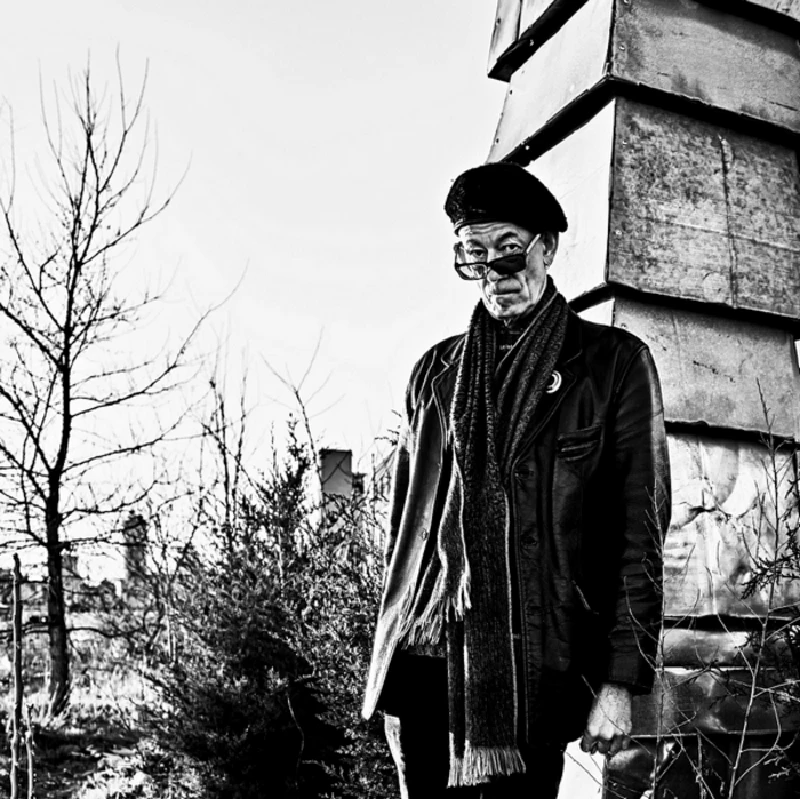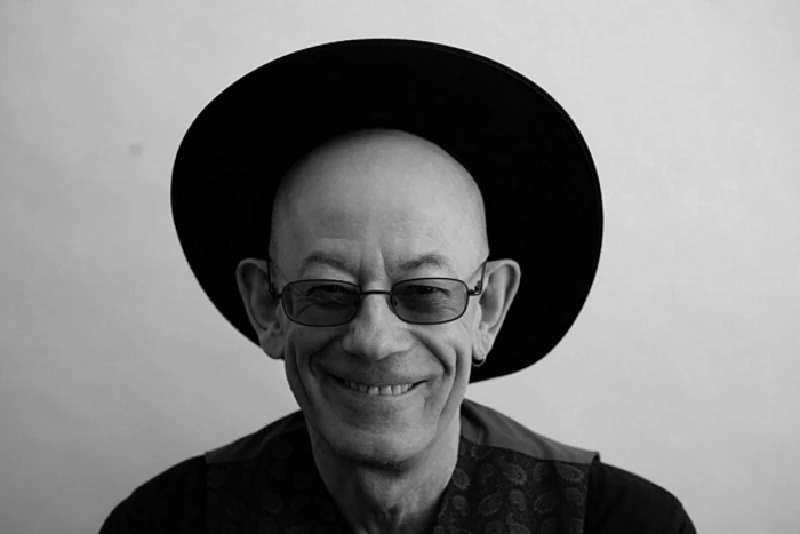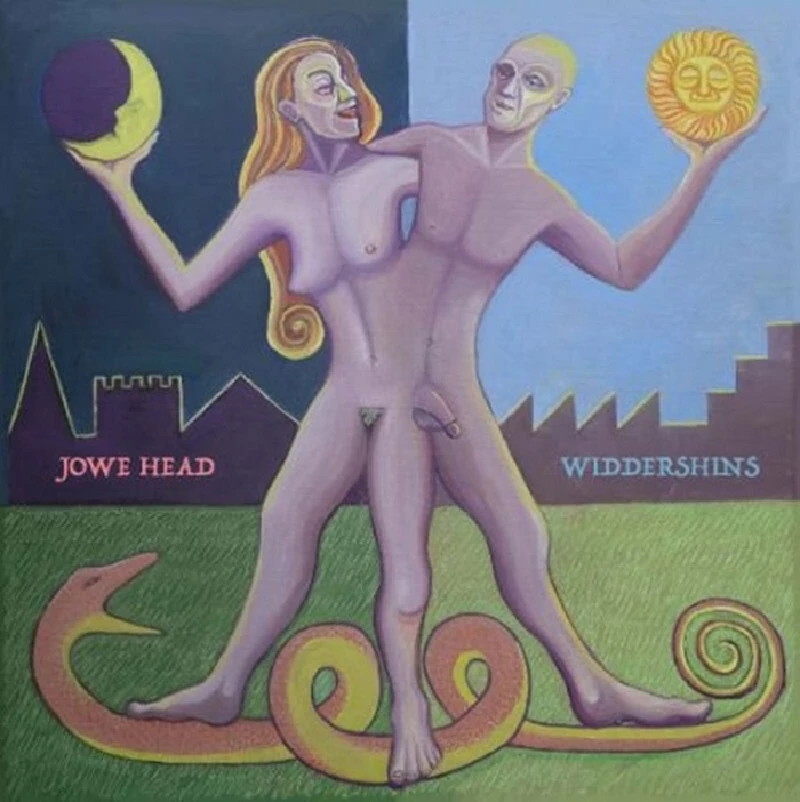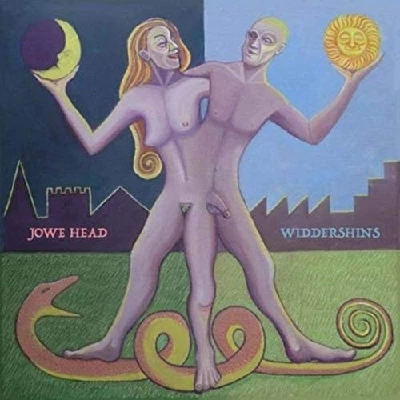Jowe Head - Interview
by Keith How
published: 31 / 5 / 2019

intro
Keith How talks to former Television Personalities and Swell Maps guitarist Jowe Head about his new solo album 'Widdershins', and is also given fascinating insights into his art and music,
Jowe Head’s career has seen him collaborating with numerous bands and musicians and creating an outstanding legacy. He has intertwined his many talents, joining forces with other like minds and creating a prolific career in the post punk and experimental underground. He has throughout pursued his own vision, generally ignoring mainstream trends and fashion. He also has an impressive solo back cataloguem along with his work with bands such as the Television Personalities, Swell Maps, the Palookas and the Demi Monde. His striking paintings and artworks are exhibited regularly to critical acclaim. Pennyblackmusic spoke to Jowe Head about his new vinyl only solo album 'Widdershins' and his artwork PB: The new album 'Widdershin' appears to be mostly a journey into and around English folklore. Is this something you have been exploring recently? JH: Roughly half of 'Widdershins' consists of my interpretations of old British songs from so-called ‘traditional’ or ‘folk’ music sources. The rest are my original compositions, plus a few cover versions that seemed to be appropriate. It is the culmination of a period where I started to explore and research the music of a distant murky past, which forms a neglected part of our nation’s culture, and try to wrench it into the present and even the future. Themes include damnation and redemption (‘Lyke Wake Dirge’), urban alienation (‘Nottumun Town’), madness (‘Tom O’Bedlam’), cosmology (‘Gower Song’), talking birds and shipwrecks (‘Two Ravens’), and agricultural parasites (‘Bolweevil Holler’). My interest in this field was initially stimulated by hearing a version of ‘John Barleycorn’ by the psychedelic band Traffic in the early 1970s; the enigmatic lyrics intrigued me, and I realised that it had a highly profound theme concerning natural cycles encompassing birth, suffering, death and rebirth. I have taken this song and reimagined it on this album as an almost unrecognisable piece called ‘King of the Corn’. I have no ambitions to be an ‘authentic’ folk singer, but I am intrigued by some of these strange old songs, which are often haunting and ambiguous. Typically, they are the work of anonymous composers, whose names have been lost and forgotten, and transmitted down countless generations by an oral tradition. It was only in the last century that researchers, academics and enthusiasts started to actually see a value in the material and document it, to avoid it being totally lost altogether due to neglect and modern changes in lifestyles. In every case I have altered the melody, or the lyric, to suit my style and aimed to take an intuitive approach. If purists do not care for my efforts, then let them listen to a field recording from a hundred years ago! PB: 'Widdershins' is generally considered a superstition and unlucky. Are you a superstitious person? Do you believe in luck? JH: I like the concept of 'Widdershins', because I naturally seem to enjoy swimming against the tide, be that of prevailing fashions, or of authority, or convention. I do not consider myself superstitious, but I note how such beliefs still prevail in modern society. For example, people still knock on wood, or cross their fingers for luck, even if it is somewhat jokingly. I am interested in the concept of good or bad ‘luck’, but I believe that we often create our own conditions in terms of our fortune. Our fates often seem random or bafflingly driven by unseen forces. Science tries to make us rely upon reason, and reassure us that everything is driven by our DNA or by easily explained natural cycles, but we live in a chaotic universe, and many of us in this increasingly secular society seem to be constantly striving to find something - anything - to give a meaning to our godless lives, and explain our fate. PB: 'The Minotaur Song' is an interesting song to cover. The Minotaur has two personalities. As you are involved in various different projects do you have to adjust your own personality to whatever project you are working with? JG: Personally I worship nature, and accept no gods, but mythology is endlessly fascinating. I love reading about mythology, especially from Egyptian, Norse and Greek cultures; they are a rich resource of philosophical ideas, cautionary tales and surreal concepts. I enjoyed working on ‘Minotaur Song’, because it is dark, but strangely jolly, and I aimed to attack it with a certain relish. The original was by the Incredible String Band, but with a simple piano backing. Adding some electronic elements and distortion to a song like this seems to bring it to life. As with the other pieces, I have tried to blend old instruments such as zithers, bowed psaltery and double-bass, with electric guitar and analogue synthesiser. The recordings were made at my own home studio, and I have aimed to keep the sound quite minimal and primitive with plenty of space, not overcrowding it with too many overdubs. As for the Minotaur himself, he is an amalgam of human and beast. I cannot identify with this creature; I see the figure as a monstrous parody of macho posturing, brutal and deformed, destroying anyone who gets into his sight. I, however, accept that as a typical Gemini, I have what could be seen as two sides to my character: I am deadly serious about my creative work, but I also enjoy bringing a sense of humour and mischief into the mix. I am constantly considering how to achieve a balance between certain elements: brightness/darkness, loudness/quietness, acoustic/electric. I believe that some objects in the material world possess a kind of magical presence, so maybe I am like an animist. I remember reading about the concept of ‘contagious magic’, defined by the anthropologist J.G. Frazer in his book, 'The Golden Bough', which notes that some cultures believe that people can adopt magical powers from such objects by physical contact. Why else do people wear crosses and carry lucky charms? I collect and sometimes wear many objects that seem to have a kind of presence that I cannot explain. Sometimes I use them in collages or montages or assemblages, whatever you want to call them. Making unlikely combinations of objects into a composition can be strangely satisfying, and seems to reassemble the normal order of things. Recently I made a piece using empty nitrous oxide capsules that I found in the road, assembled in a pleasing pattern, combined with glass crystals, in a pattern on a hexagonal piece of wood. I cannot explain why but it seems satisfying. Similar impulses happen in music; it is exciting to mix up rock and roll with classical and folk music elements, then insert white noise, half-forgotten nursery rhymes and bits of film themes and so on. PB: Do new projects or collaborations come to you by accident or design. Do you sometimes decide this one is not for me ? JH: Yes, I collaborate with many different musicians on various projects. This album features some of these musical kindred spirits. The collaborators here have been vital elements in these pieces, and help to provide an interesting variety of sounds. Queen Christina (aka Christina Bodie) helped me with keyboards and voice on four tracks, one of which she wrote. Singer/pianist Maria Moraru helped me arrange two other tracks. Singer Catherine Gerbrands and cellist Tim Bowen from my previous band The Demi-Monde helped me on three tracks. Guitarist extraordinaire Heath Stanley (from Olive’s Hairy Custard) helped me on three songs, and Rico Conning helped me on three more. I have a number of projects at various stages. Some of them evolve over a longer period, others seem to happen quite quickly. I recently started to make music with Glaswegian singer Rose McDowall (ex-Strawberry Switchblade) after we met in Glasgow sharing a bill at a concert. I have just released an album with Eleventh Hour Adventists, who are basically a duo of myself with Jasmine Pender (aka Rotten Bliss), who plays electric cello; I play guitar and mandocello. We both sing and compose the material and play live regularly with a drummer as a trio. A more complex combo is Infernal Contraption which is a five piece band for which I write the songs; we use conventional instruments - bass, drums, guitar - with more unusual sounds like Theremin and xylophone. Another band I play regularly with is Rude Mechanicals, for whom I mainly play synthesiser. Later this year, I am hoping to complete an album that I started with a synth player, the late John Several (Tactile), called Hawksmoor Brood. I bring different ideas to each collaboration, I think. For example, in some of them I play in the shadows, and others I am at the front of the stage, singing. My intuition with other musicians seems to work well on the whole. I do not often refuse a project that is offered. I cannot remember deciding to work with someone on a project that has turned out to be a waste of time! I cannot remember having any arguments either. It’s important to leave one’s egotism at the cloakroom; it is a good opportunity to leave one’s comfort-zone and try a fresh approach. It is worthwhile to be generous and allow each person to contribute to the process in their own way. Each collaboration has turned out to be a stimulating learning process for me and hopefully for the others. I like to stretch myself creatively. The main problem is fitting in everything and avoiding conflicts between various projects. Scheduling rehearsals and recording dates to fit everyone’s needs is a headache sometimes! PB: Your artwork is fascinating. Is there any tension between painting and making music? Perhaps they are the same thing. Could you give us an insight into how the two disciplines work for you ? JH: When I am not making music, I enjoy making images - in paint, drawing with pencil, print-making, figures and sculptures with found objects, and so on. I find that visual expression uses the same kind of impulses that my music employs, and the two feed off each other. After all, I need to make images to go with the record covers, don’t I? The idea of getting someone else to design a cover is unthinkable! I also make my own videos to go with some of the songs, so the two senses of sight and sound are intimately connected there. Inevitably, the musical life seems to dominate, because there is more demand for it, but I try to keep a balance between the two. Some common themes in the imagery in recent paintings include alchemy, anthropomorphic animals, animal/machine hybrids, hermaphrodites, the Green Man, copulating trees, Ancient Egyptian mythology, and so on. These kind of themes inhabit the songs as well. I might sometimes draw a story-board for a song-video, but I rarely illustrate a song’s lyrics directly in paint; it is not so simple as that! PB: Recently you advised artists to paint their own shirts. Yours are far out. Do you use acrylic paints on these creations? JH: Painting shirts is not a new idea for me; I was doing that in the 1980s, to wear on stage, but I’ve recently started to take it more seriously and taking more care with the execution, instead of rushing it. I use fabric paints, painting usually in black outline with a fine brush onto a stretched white cotton shirt, then adding colours. I recently painted a simple pattern of repeating interlocking hexagons which worked well. Another one used alchemical imagery and other esoteric symbols. I’ve also painted a Viking design in white onto a black shirt which is a pleasing effect. I recently received a commission to paint a shirt for a fellow performer, which was pleasing, and it was gratifying to see him wear it on stage! PB: Thank you.
Band Links:-
https://www.facebook.com/Jowe-Head-241535806282/https://twitter.com/jowehead
https://en.wikipedia.org/wiki/Jowe_Head
Play in YouTube:-
Picture Gallery:-


Visitor Comments:- |
| 916 Posted By: David Nichols, Melbourne on 02 Apr 2020 |
|
I really enjoyed this
|
interviews |
|
Interview (2019) |

|
| Keith How talks to former Television Personalities and Swell Maps guitarist Jowe Head about his new solo album 'Widdershins', and is also given fascinating insights into his art and music. |
reviews |
|
Widdershins (2019) |

|
| Sprawling but creative and versatile double vinyl LP from Television Personalities and Swell Maps legend Jowe Head |
most viewed articles
current edition
Carl Ewens - David Bowie 1964 to 1982 On Track: Every Album, Every SongArmory Show - Interview with Richard Jobson
John McKay - Interview
Colin Blunstone - Thalia Hall, Chicago, 16/7/2025
Bathers - Photoscapes 1
Billie Eilish - O2 Arena, London, 10/7/2025
Loft - Interview
Visor Fest - Valencia, Spain, 26/9/2025...27/9/2025
Sir Tim Rice - Interview
Robert Forster - Interview
previous editions
Manic Street Preachers - (Gig of a Lifetime) Millennium Stadium, Cardiff, December 1999Heavenly - P.U.N.K. Girl EP
Beautiful South - Ten Songs That Made Me Love...
Oasis - Oasis, Earl's Court, London, 1995
Peter Perrett - In Dreams Begin Responsibilities Interview Part One
Boomtown Rats - Ten Songs That Made Me Love....
Coldplay - Wembley Arena. London, 16/8/2022
Prolapse - Interview
Trudie Myerscough-Harris - Interview
Pixies - Ten Songs That Made Me Love...
most viewed reviews
current edition
Davey Woodward - Mumbo in the JumboSick Man of Europe - The Sick Man of Europe
Lucy Spraggan - Other Sides of the Moon
Amy Macdonald - Is This What You've Been Waiting For?
Phew, Erika Kobayashi,, Dieter Moebius - Radium Girls
Suzanne Vega - Flying With Angels
Bush - I Beat Loneliness
Alice Cooper - The Revenge of Alice Cooper
Cynthia Erivo - I Forgive You
Blueboy - 2
Pennyblackmusic Regular Contributors
Adrian Janes
Amanda J. Window
Andrew Twambley
Anthony Dhanendran
Benjamin Howarth
Cila Warncke
Daniel Cressey
Darren Aston
Dastardly
Dave Goodwin
Denzil Watson
Dominic B. Simpson
Eoghan Lyng
Fiona Hutchings
Harry Sherriff
Helen Tipping
Jamie Rowland
John Clarkson
Julie Cruickshank
Kimberly Bright
Lisa Torem
Maarten Schiethart